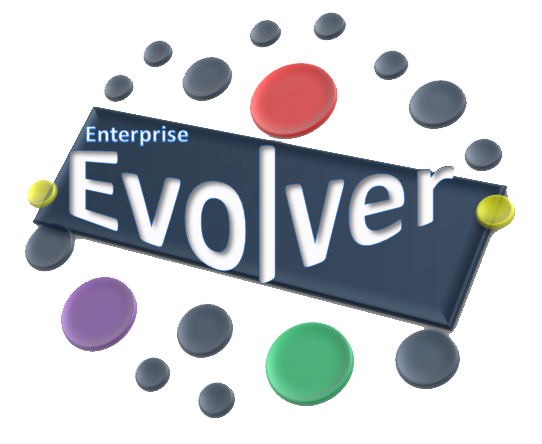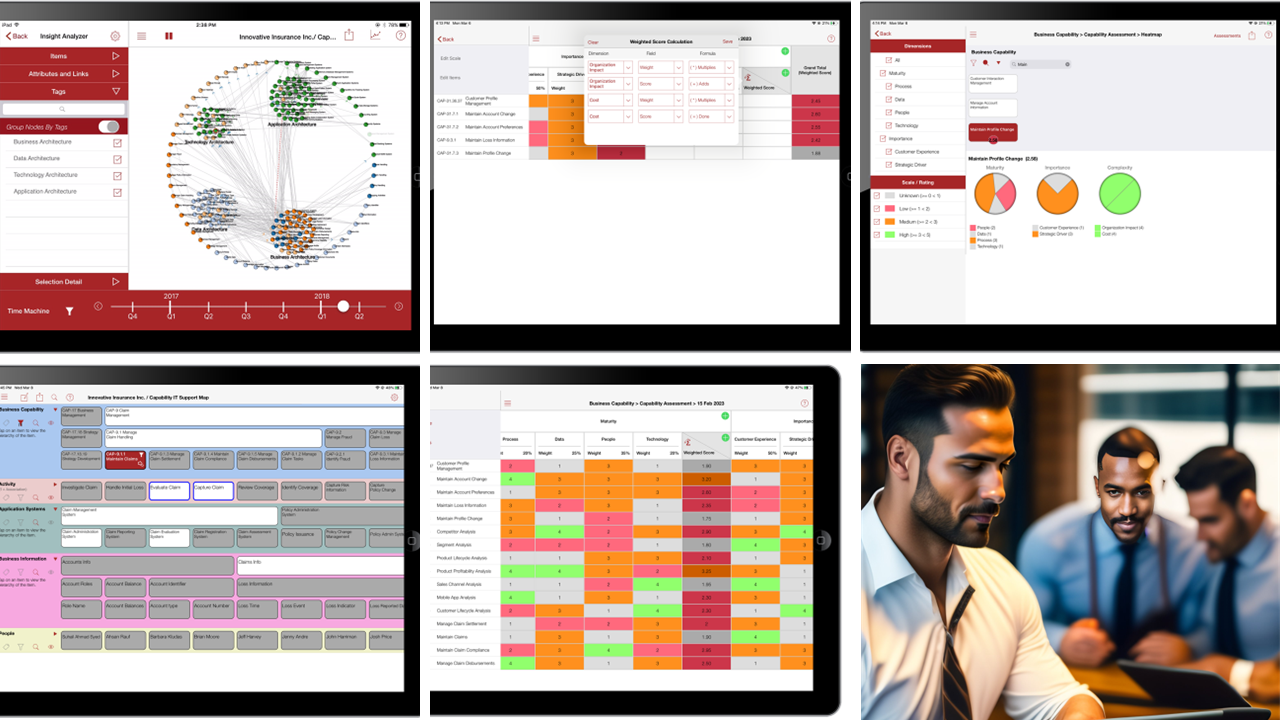A strategic roadmap is a visual representation of a company’s long-term goals and the steps it plans to take to achieve them. A Capability-driven strategic roadmap can be used by various stakeholders to align their efforts with the overall business strategy, prioritize initiatives, improve decision-making, and measure progress. Business leaders can use it to align their initiatives with the overall business strategy, while IT leaders can use it to prioritize and align technology investments. Program portfolio leaders can use it to prioritize initiatives and allocate resources, and business analysts can use it to gather data and make informed decisions. The roadmap can also be used by customer experience professionals to improve the customer experience, and by enterprise, architects to demonstrate the value of their architecture program. By using the roadmap, all stakeholders can work together to support the business strategy and achieve desired outcomes.
Enterprise architecture (EA) is a discipline that provides a framework for aligning business processes, systems, and technology with organizational strategy. By integrating EA models and practices into your organization’s strategic planning process, you can create a roadmap for achieving your business goals and outcomes.
Here’s how you can get started:
- Define your business strategy and outcomes
The first step in creating a strategic roadmap is to define your business strategy and outcomes. This includes defining your vision, mission, and goals, and determining the specific outcomes you want to achieve. This information will serve as the foundation for your EA efforts. Go to the Designer page and click on Business Context and then Goal to create strategic goals, Use Metric to define measurements or KPIs that will be used to measure the result or outcome to achieve the desired goal.
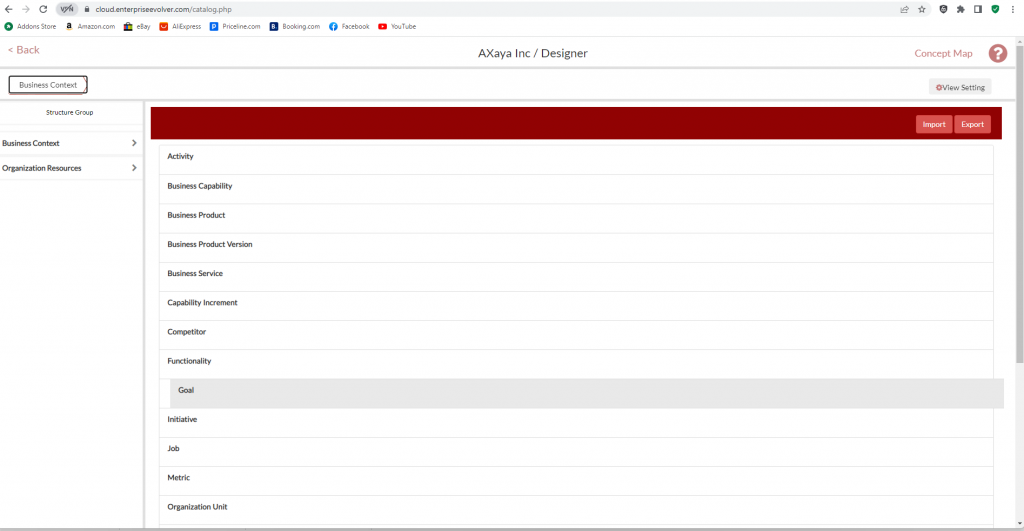
- Assess your current state
Once you have defined your business strategy and outcomes, you need to assess your current state. This involves conducting a thorough analysis of your business capabilities, systems, and technology. This analysis will help you identify areas where improvements are needed and provide a baseline for your future EA efforts. Simply, click on Business Capability and if the capability model is not created, then first create the capability model by clicking on ‘Maintain Capability Model’ of your business and then do an assessment of capabilities that will deliver the outcomes for the desired goals. You can use pre-defined dimensions/factors like maturity, importance, complexity or your own defined factors to assess the current and future state of business capabilities. Scoring each capability by defining capability factors and weight help business leaders understand which capability they need to invest in and which capabilities need to be priorities to be placed in the strategic roadmap.
Evolver automatically generates a capability heatmap highlighting weaknesses in current capabilities. The bubble chart can be used to analyze the capability from many dimensions (e.g. maturity, complexity Strategic importance etc.). These models help planners to identify investment opportunities, such as which capability requires immediate attention and what capabilities require attention at a later stage. Select the Heatmap option to generate the capability heatmap. Select the Bubble chart to show data from many different dimensions.
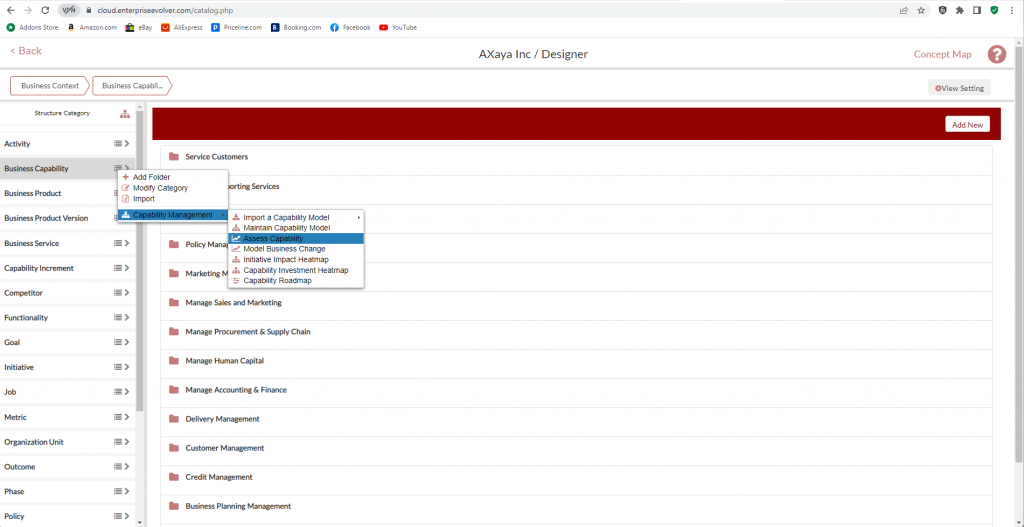
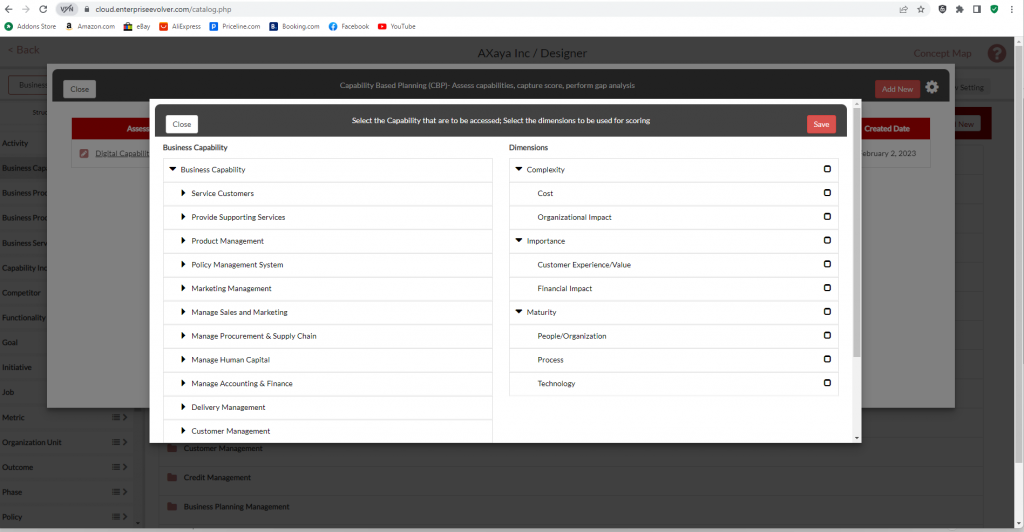
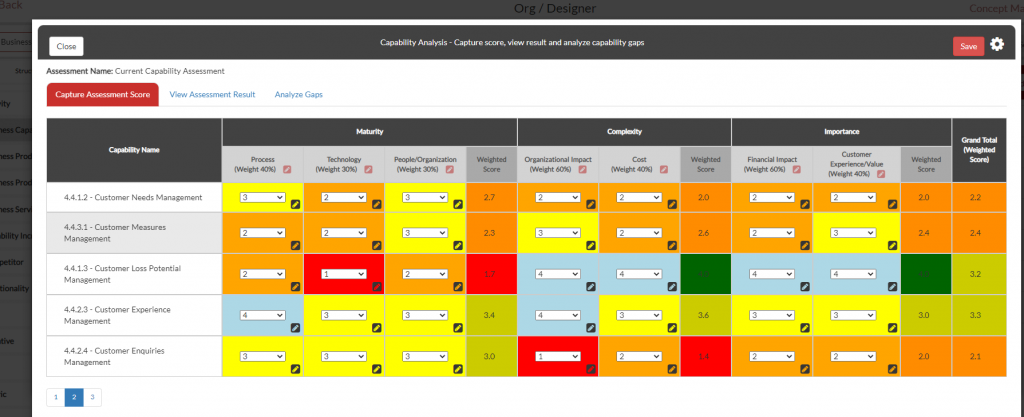
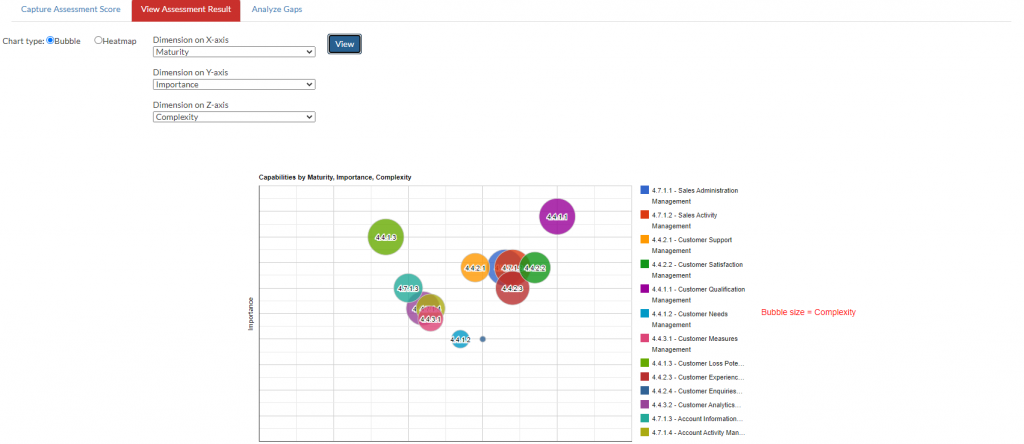

- Develop a target state and Perform a Gap Analysis
Based on your current state analysis of the business capability model, develop a target state that aligns with your business strategy and outcomes. This includes defining the desired future state of your business capabilities in terms of its maturity and identifying the changes required to get there. In Enterprise Evolver, you can perform a new assessment of capabilities and visualize the capability gaps. Identification of Capability gaps assists in fulfilling the business needs in order to achieve its strategic goals. Evolver allows you to compare current state capability scores with future state scores to generate a graph to illustrate the gap between the target and current state. Evolver generates a graph to show the gap between different states of capabilities. The gap analysis reports help senior leaders to identify those capabilities which are needed to be improved or transformed.
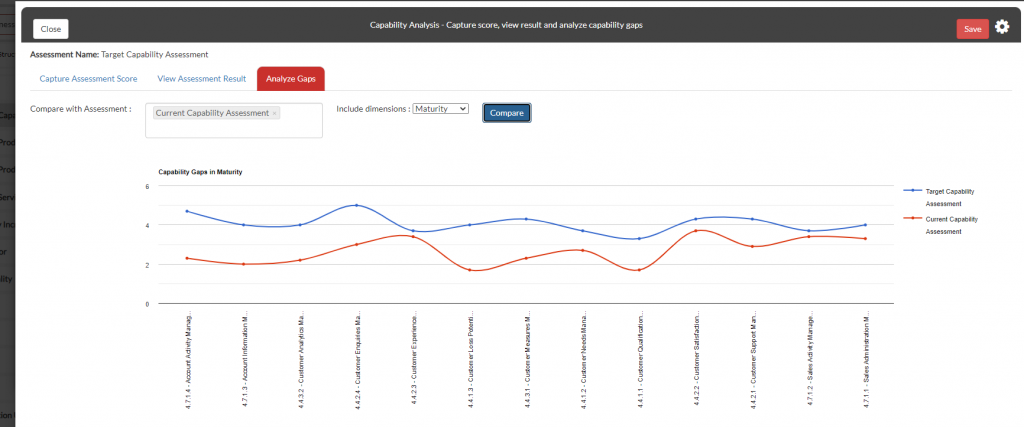
- Model Business Change to generate a Strategic roadmap
Before a strategic roadmap is created, a business change is modelled. Evolvers allow you to model the business change by creating capability increments. Each capability increment represents a change, a change could be minor, major or transformative. A minor change represents simply adding a few product features to existing capability.
Each capability increment is assigned an indicator to describe how a capability will evolve over time. Each increment is considered a particular state of capability at a certain point in time. Here an indicator is assigned to each capability dimension to describe what aspect of the capability is important in each increment. A higher indicator value (e.g. 4 or 5) for the process dimension for an increment indicates that the improvement in the process dimension is important for the stakeholders. A lower indicator value for a dimension indicates that this dimension is not much important to the stakeholders.
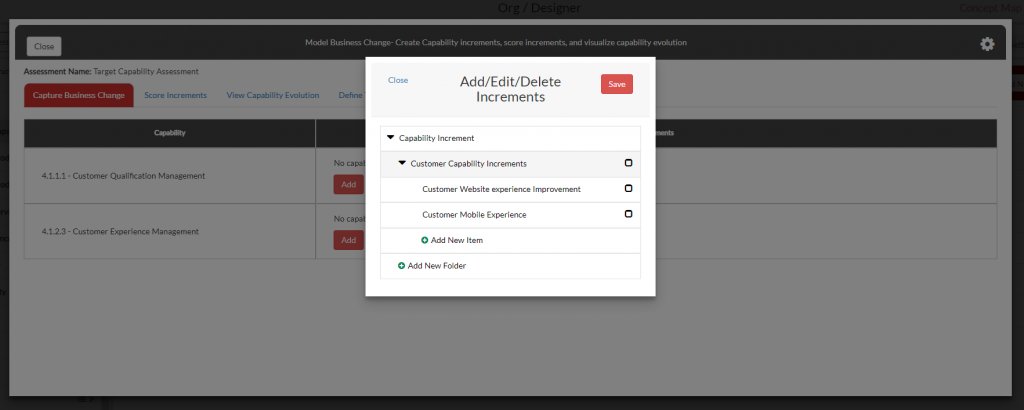
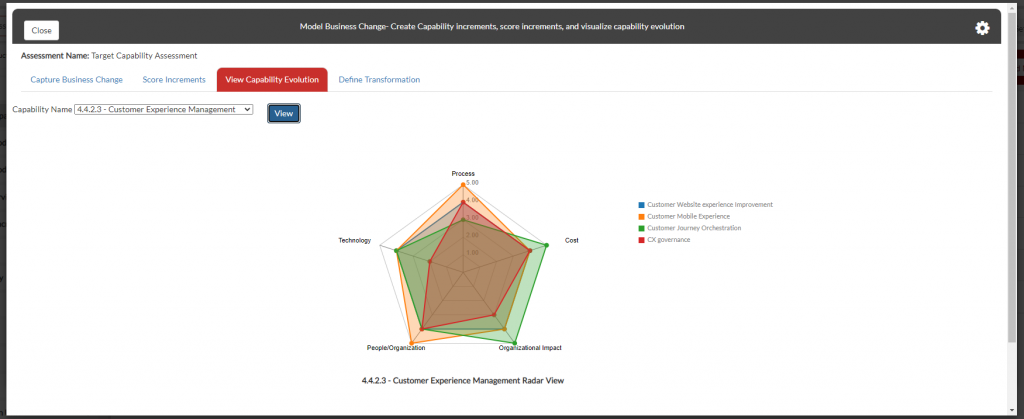
For each capability, Evolver generates a radar view to depict how the capability will evolve via various increments. These diagrams also help stakeholders the order of dimensions (e.g. Skill acquisition, then business process redesign followed by technology investment) in which the capability improvement will take place. Select a capability and click on the View button to generate the radar diagram.
The next step is to define the Transformation Initiative, simply click on the ‘Define Transformation’ tab. For a large initiative, multiple phases can be created in which capabilities will be improved. Add all capabilities that will be enhanced or transformed as part of the transformation. In each initiative, impacted capabilities are included; capability increments are added; capability timeline is captured; resources are leveraged and outcomes and requirements are captured. The deliverable of this step is a capability roadmap and a business case document.
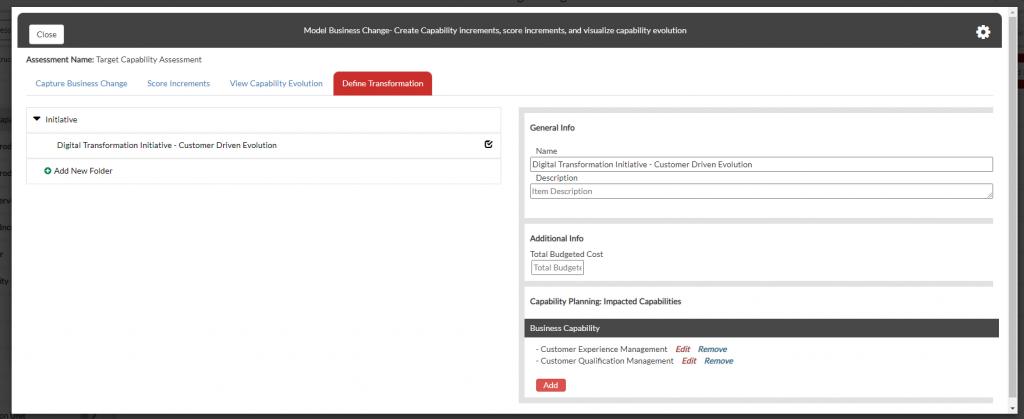
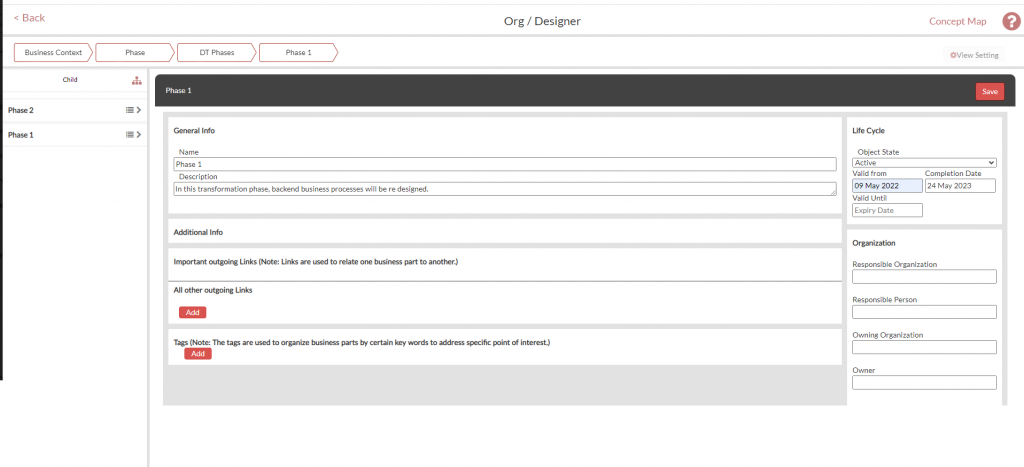
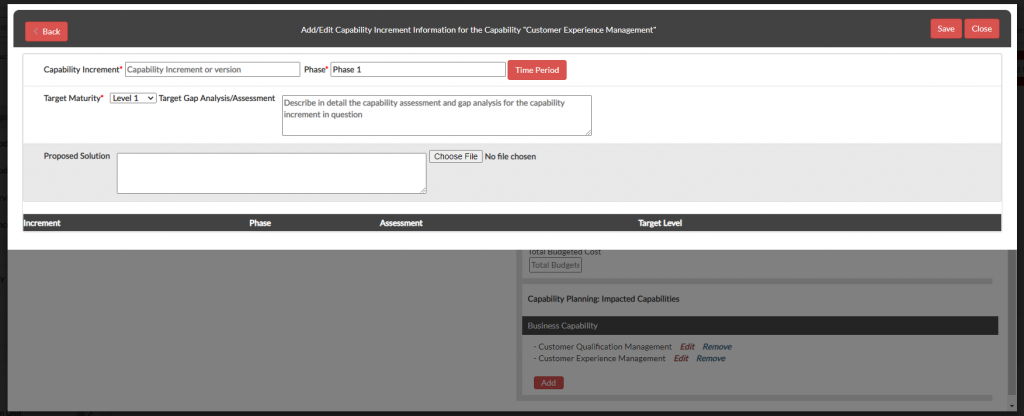
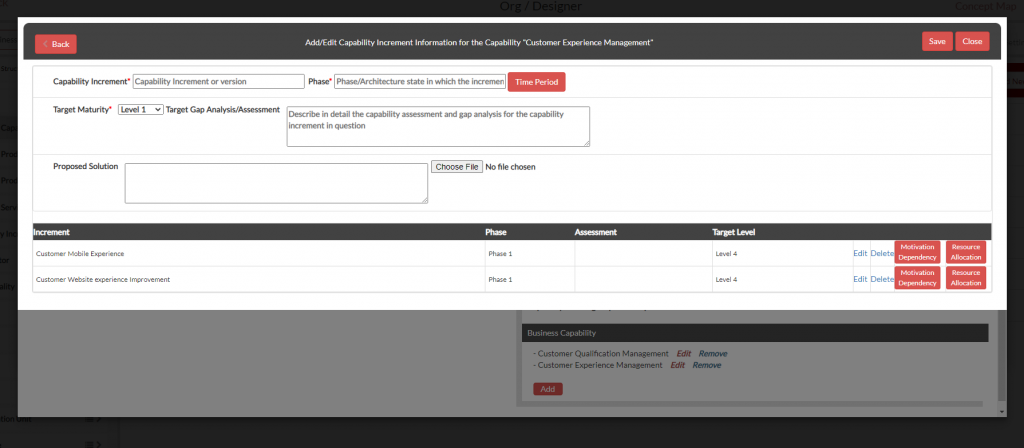
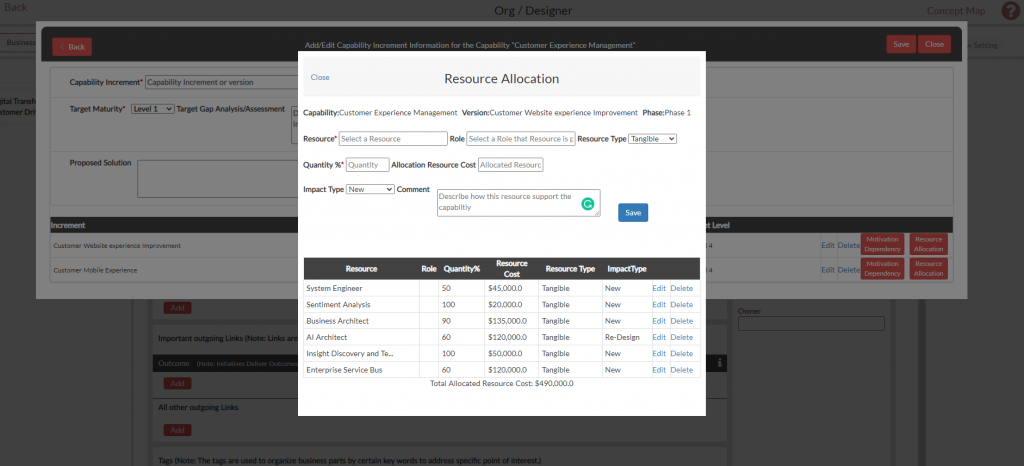
- Implement and monitor
Evolver generates a strategic roadmap that includes timelines, budgets, and resources needed to implement each capability. The roadmap also provides a clear understanding of the interdependencies between different elements of your enterprise architecture efforts. Evolver generates various views of the strategic roadmap, including an illustration of how two capabilities, such as Customer Qualification Management and Customer Experience Management, will be improved through various increments and the timeline, cost, and dependencies associated with each improvement.
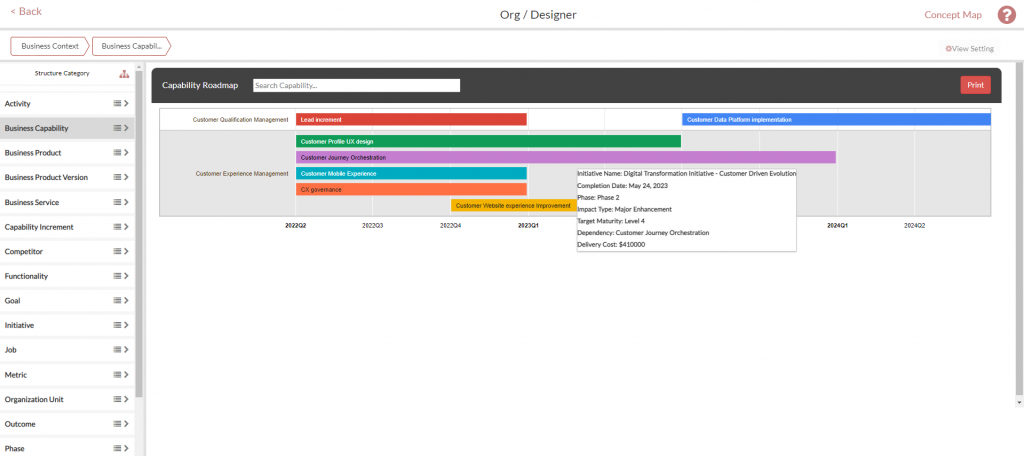
Once you have created your EA roadmap, it’s time to start implementing it. This involves making changes to your business processes, systems, and technology, as well as training employees on the new processes and systems. You should also regularly monitor your EA efforts to ensure that they are on track and making a positive impact on your business outcomes.
If goals and priorities change, you can easily update the resume
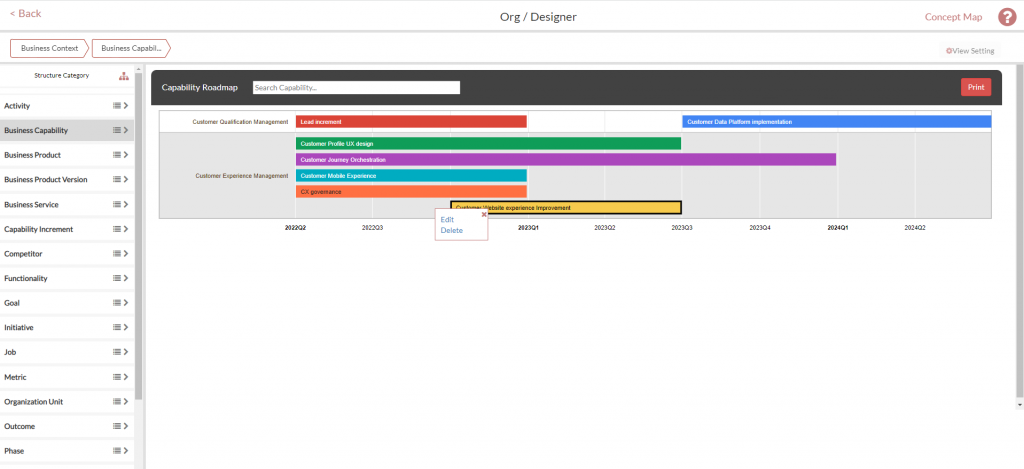
In conclusion, by integrating EA models and practices into your organization’s strategic planning process, you can create a roadmap that supports your business strategy and outcomes. This will help you align your business processes, systems, and technology with your organizational goals and ensure that you are able to achieve your desired outcomes.
Benefits of a Strategic Roadmap
A business leader can use a strategic roadmap to communicate the company’s vision and direction to stakeholders, align teams around common goals, align digital initiatives with business outcomes, and make data-driven decisions. It can also help leaders prioritize initiatives, allocate resources effectively, and track progress towards achieving their goals. Additionally, a strategic roadmap can help leaders identify potential roadblocks and adjust their plans. A strategic roadmap can be used by a business leader in several ways:
- Aligning efforts with business strategy: The roadmap serves as a visual representation of the steps needed to achieve the desired business outcomes, ensuring that all efforts are aligned with the overall business strategy.
- Prioritizing initiatives: The roadmap helps the business leader prioritize initiatives based on their importance and impact on the business outcomes, allowing for a more focused and effective allocation of resources.
- Communicating goals: The roadmap provides a clear and concise way to communicate the business goals and outcomes to employees, stakeholders, and other key audiences, promoting a shared understanding of the organization’s direction and objectives.
- Measuring progress: The roadmap provides a framework for tracking progress and measuring the success of initiatives, allowing the business leader to make informed decisions about future investments and adjust the strategy as needed.
- Building consensus: The creation of the strategic roadmap involves input from different departments and stakeholders, building consensus and buy-in for the overall business strategy and goals.
By using the strategic roadmap, a business leader can ensure that the organization is moving in the right direction, making informed decisions, and effectively utilizing resources to achieve desired outcomes.
An IT leader can use the strategic roadmap in several ways to align their technology efforts with the overall business strategy and goals:
- Aligning technology with business strategy: The IT leader can use the roadmap to align their technology initiatives and investments with the business strategy and desired outcomes, ensuring that technology is leveraged to support and drive the business forward.
- Driving innovation: The roadmap provides a framework for the IT leader to identify areas where technology can drive innovation and support the business in new and creative ways, promoting the use of technology as a competitive advantage.
- Optimizing resources: By using the roadmap to prioritize technology initiatives, the IT leader can optimize their resources and ensure that they are being used effectively to support the business goals.
- Improving alignment: The strategic roadmap helps the IT leader improve alignment between their technology efforts and the overall business strategy, reducing the risk of technology investments that do not support the business goals.
- Communicating plans: The roadmap provides a clear and concise way for the IT leader to communicate their technology plans and initiatives to other business leaders and stakeholders, promoting transparency and understanding of the role of technology in the organization.
By using the strategic roadmap, an IT leader can ensure that their technology efforts are aligned with the business strategy and goals, drive innovation, optimize resources, improve alignment, and effectively communicate their plans to key stakeholders.
A program portfolio leader can use the strategic roadmap in several ways to align their program portfolio with the overall business strategy and goals:
- Aligning program portfolio with business strategy: The roadmap serves as a framework for the program portfolio leader to align their programs and initiatives with the business strategy and desired outcomes, ensuring that their efforts are contributing to the overall success of the organization.
- Prioritizing programs: The roadmap helps the program portfolio leader prioritize their programs based on their importance and impact on the business outcomes, allowing for a more focused and effective allocation of resources.
- Measuring success: The roadmap provides a framework for tracking progress and measuring the success of programs, allowing the program portfolio leader to make informed decisions about future investments and adjust their portfolio as needed.
- Building consensus: The creation of the strategic roadmap involves input from different departments and stakeholders, building consensus and buy-in for the overall business strategy and goals.
- Communicating plans: The roadmap provides a clear and concise way for the program portfolio leader to communicate their program portfolio plans and initiatives to other business leaders and stakeholders, promoting transparency and understanding of their role in the organization.
By using the strategic roadmap, a program portfolio leader can ensure that their programs are aligned with the business strategy and goals, prioritize their efforts, measure success, build consensus, and effectively communicate their plans to key stakeholders.
A business analyst can use the strategic roadmap in several ways to support the overall business strategy and goals:
- Understanding business strategy: The roadmap provides a clear and concise representation of the business strategy and desired outcomes, allowing the business analyst to better understand the organization’s goals and objectives.
- Identifying areas for improvement: The roadmap serves as a framework for the business analyst to identify areas where the organization can improve and make more effective use of resources.
- Supporting decision making: The business analyst can use the roadmap to gather data and conduct analysis that supports informed decision making, helping to ensure that decisions align with the overall business strategy.
- Defining requirements: The roadmap provides a basis for the business analyst to define the requirements for initiatives and projects, ensuring that they support the desired business outcomes.
- Improving communication: The roadmap helps the business analyst communicate the business strategy and desired outcomes to stakeholders, improving understanding and alignment across the organization.
By using the strategic roadmap, a business analyst can better understand the business strategy, identify areas for improvement, support decision making, define requirements, and improve communication with stakeholders.
An enterprise architecture (EA) program can use the strategic roadmap to demonstrate the value of their architecture program in several ways:
- Aligning architecture with business strategy: The EA program can use the roadmap to align their architecture efforts with the business strategy and desired outcomes, demonstrating the critical role of architecture in supporting the organization’s goals.
- Identifying opportunities for optimization: The roadmap provides a framework for the EA program to identify areas where the organization can optimize its technology and systems to better support the business strategy, demonstrating the value of their architecture efforts.
- Improving decision making: The EA program can use the roadmap to provide data and analysis that supports informed decision making, demonstrating the value of their architecture work in improving the organization’s ability to make effective decisions.
- Enabling innovation: By using the roadmap to identify areas where technology can drive innovation and support the business in new and creative ways, the EA program can demonstrate the value of their architecture efforts in promoting technology as a competitive advantage.
- Improving alignment: The strategic roadmap helps the EA program improve alignment between their architecture efforts and the overall business strategy, demonstrating the value of their architecture program in reducing the risk of technology investments that do not support the business goals.
By using the strategic roadmap, the EA program can demonstrate the value of its architecture efforts by aligning with the business strategy, identifying opportunities for optimization, improving decision-making, enabling innovation, and improving alignment across the organization.
A customer experience (CX) professional can use the strategic roadmap in several ways to improve the overall customer experience and support the business strategy:
- Aligning CX with business strategy: The roadmap serves as a framework for the CX professional to align their efforts with the overall business strategy and desired outcomes, demonstrating the critical role of CX in supporting the organization’s goals.
- Identifying areas for improvement: The roadmap provides a framework for the CX professional to identify areas where the organization can improve the customer experience, demonstrating their commitment to delivering a high-quality experience to customers.
- Improving decision making: The CX professional can use the roadmap to gather data and conduct analysis that supports informed decision making, improving the ability of the organization to make effective decisions about the customer experience.
- Enabling innovation: By using the roadmap to identify opportunities for technology and process innovations that can improve the customer experience, the CX professional can demonstrate the value of their efforts in driving competitive advantage.
- Improving communication: The roadmap helps the CX professional communicate their plans and initiatives to other business leaders and stakeholders, improving understanding and alignment across the organization.
By using the strategic roadmap, a CX professional can align their efforts with the business strategy, identify areas for improvement, improve decision making, enable innovation, and improve communication with stakeholders, demonstrating the value of their work in improving the overall customer experience.
A strategic roadmap can play a critical role in supporting a digital transformation by:
- Aligning digital initiatives with business strategy: The roadmap provides a framework for aligning digital initiatives with the overall business strategy and desired outcomes, ensuring that technology investments support the organization’s goals.
- Identifying areas for transformation: The roadmap provides a basis for identifying areas where the organization can leverage digital technologies and processes to improve business operations and customer experience, promoting digital transformation.
- Improving decision making: The roadmap helps the organization make informed decisions about digital initiatives, ensuring that investments align with the overall business strategy.
- Prioritizing initiatives: The roadmap provides a basis for prioritizing digital initiatives, ensuring that resources are effectively deployed to support the most impactful initiatives.
- Improving communication: The roadmap helps to improve communication between business leaders and IT teams, ensuring that all stakeholders understand the goals and objectives of the digital transformation.
- Measuring progress: The roadmap provides a basis for measuring progress and outcomes, ensuring that the organization is able to track its progress and adjust its strategy as needed.
- Reducing risk: The roadmap helps to reduce risk by providing a basis for informed decision making and prioritizing initiatives, reducing the risk of investments in digital initiatives that do not support the overall business strategy.
By using a strategic roadmap to support a digital transformation, the organization can align its digital initiatives with the business strategy, identify areas for transformation, improve decision making, prioritize initiatives, improve communication, measure progress, and reduce risk.
#StrategicRoadmap #BusinessStrategy #BusinessOutcome #EnterpriseArchitecture #ITLeadership #ProgramPortfolio #BusinessAnalysis #CustomerExperience #Innovation #ValueCreation #Alignment
